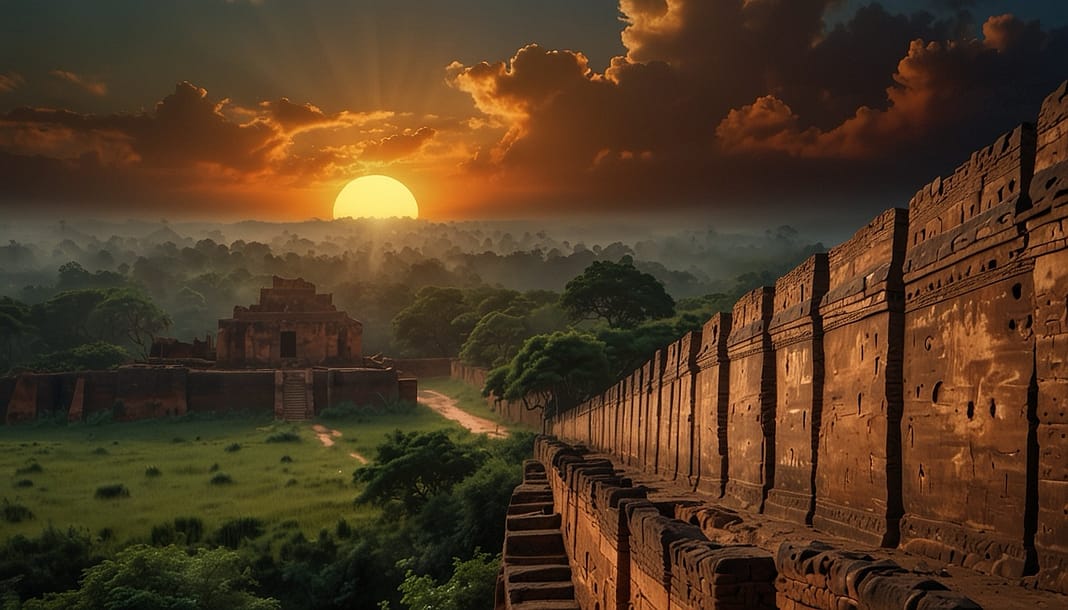There are structures that rise from the earth, quietly holding the stories of a people who built them, the songs of those who stood in their shadow. And then there are those structures, towering and grand, that the world simply forgets. The Walls of Benin belong to both stories.
If you had ever walked in the heart of the ancient Benin Kingdom, in what is now southern Nigeria, you would have seen them—walls stretching far beyond the horizon, tangling together the fates of its people, its kings, its warriors. These were not mere fortifications. No, they were a testament, an ode to a civilization whose hands shaped the soil into ramparts, over 10,000 miles long, circling their cities and their lives like a lover protecting the beloved.
Imagine the earth whispering under the strain of human ambition: 150 million hours of sweat, toil, and vision to craft what is now considered one of the largest man-made structures in human history. Yes, the very walls that outstripped the Great Wall of China in both scale and complexity, yet barely a soul knows of them. How could something so grand, so deep-rooted in human spirit, be erased from the memory of our collective humanity?
The tragedy of the Walls of Benin is not just in their grandeur or scale, but in the way their story, their essence, was destroyed in 1897 by British colonizers. Burned, looted, dismantled brick by brick, memory by memory. Imperialism, in its cold and calculating manner, reduced the story of these walls to ash. It’s a haunting silence, one where a legacy that should sing through time has been drowned out by the weight of colonial violence. But the walls—they still hum, quietly beneath the soil, in the whisper of the Edo people’s oral histories, in the hidden archives of the earth.
Today, we’re left with little physical remains. Bits of the past buried in the land, fragments of what once was. Why is this history not taught? Why do generations of Nigerian youth, and the world at large, grow up without ever hearing of the Walls of Benin, which could circle the United States three times? How does the story of a structure four times longer than the Great Wall of China slip through the cracks of our understanding? To forget a structure is to forget a people. To ignore their contributions is to deny their place in the tapestry of history.
And yet, the internet searches rise, Google’s inquiries tap into the collective curiosity. As questions pulse through cyberspace—What happened to the Walls of Benin? How were they destroyed? Why were they erased from history?—we are witnessing a reckoning, a rediscovery of the walls’ ghostly shadow. It’s almost as if the very soil is calling us back to the truth, to the realization that these walls, these immense, interlocking fortresses of earth, were as much a spiritual monument as they were a physical one.

These walls were more than defense mechanisms; they were living, breathing extensions of the city’s soul. They echoed with the sounds of rituals, with the chants of priests, the footsteps of warriors, the prayers of mothers. How did they do it? With nothing but earth, sweat, and the devotion of a people who believed their city deserved protection beyond what stone or metal could offer. They used rammed earth construction—a process both simple and profound. The clay-rich soil of the region was pounded into form, layer by patient layer, creating a structure that would stand for centuries. To stand on that earth even today, among the few remaining traces, you might still feel the hum of something ancient, something alive.
These walls were built in concentric circles, each ring holding the city tighter, from its outer villages to its sacred heart, Benin City. Historians would tell you that this was more than a practical design—it was symbolic, a physical manifestation of the kingdom’s social structure. The walls wrapped around the people like an embrace, uniting them not just in geography but in identity. To walk through the gates of Benin was to understand immediately that you were entering a kingdom deeply proud of its lineage, fiercely protective of its art, and defiantly loyal to its Oba (king).
But that pride, that art, that history was ripped apart in 1897, when British forces descended upon the city, their hearts set on looting its treasures. The famed Benin Bronzes, intricate plaques and sculptures that adorned the royal palace, were carried away like trophies of conquest, destined for museum halls far removed from their creators. It wasn’t just the bronzes that were stolen—it was a civilization’s narrative, a history wiped from textbooks and popular consciousness.
How could they take something so precious, and with it, the very foundation of the city? How could they destroy walls that had stood for hundreds of years, built with hands that understood the earth and its power? The British didn’t just attack a city; they attacked an identity, a story that stretched far beyond the boundaries of physical space.
Yet, what imperialism couldn’t foresee was that stories have roots, and roots run deep. Today, there is a resurgence, a hunger to reclaim what was lost, to uncover the secrets of these walls, and with them, the souls of the people who built them. Why now? Because the world is finally listening. Archeologists are using LiDAR technology to map the remnants of the walls, historians are sifting through oral histories, and the descendants of those who once walked beside these walls are beginning to speak their names again.
The Benin Walls are not just history—they are a reminder. A reminder that what has been buried can be uncovered. That which has been silenced will eventually find its voice.
These walls were made not just from earth, but from the collective will of a people who believed in something larger than themselves. They stood for protection, for unity, and for a belief that their kingdom was worth defending against all odds. They stood for the sacredness of place, for the recognition that the land itself is a witness to our stories.
So, why have you never heard of the Walls of Benin? The answer lies in the same systems that sought to erase the brilliance of African civilizations, that looted and burned, that reduced entire histories to footnotes. But the tide is turning. And as more questions are asked, more truths are unearthed, it becomes impossible to ignore the legacy of these walls any longer.
The story of Benin is not over. The walls may be gone, but their spirit lives on in the red earth of Nigeria, in the rising questions on the lips of a generation that is beginning to remember. In every search, in every rediscovery, the walls are being rebuilt, brick by forgotten brick, until they once again stand as a testament to the power of memory and the resilience of a people.
Discover more from The Reasoned Journey
Subscribe to get the latest posts sent to your email.


